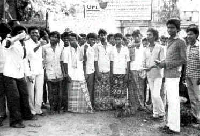State sponsored deforestation was
totally stopped by 1993 in
East Godavari Kondareddy tribes habitat |
| |
| |
| Forcing the closure of wood based industry |
| |
 "The policy of the government which has seriously affected the food supply of the Konda Reddis in this area (Eastern Ghats) is the granting of the right to fell mango trees in the forest to the Godavari Plywood factory set up in Rampachodavaram. The supply of kernels of mango stones which are a main source of food for the Reddis during rainy season is dwindling due to the felling of this fruit tree on a large scale." "The policy of the government which has seriously affected the food supply of the Konda Reddis in this area (Eastern Ghats) is the granting of the right to fell mango trees in the forest to the Godavari Plywood factory set up in Rampachodavaram. The supply of kernels of mango stones which are a main source of food for the Reddis during rainy season is dwindling due to the felling of this fruit tree on a large scale."
Prof. Christoph von Furer Haimendorf in
Tribes of India: Struggle for Survival,
Oxford University Press 1982 |
| |
| |
| |
 The East Godavari Forest working plan proposed the virgin forests of Rampa and Gudem Agencies and an area of 80,780 hectares was earmarked for selection working on 20 year felling cycle. The factory started working from 1976 and worked on 9 of the 20 coupes. The East Godavari Forest working plan proposed the virgin forests of Rampa and Gudem Agencies and an area of 80,780 hectares was earmarked for selection working on 20 year felling cycle. The factory started working from 1976 and worked on 9 of the 20 coupes.
Political Economy of State Property and the Commons Forests of the Rampa Country of South India, Prof. D.Narasimha Reddy, University of Hyderabad. Paper presented in the fifth annual common Property conference on "Reinventing the Commons", International Association for the Study of Common Property Bodo, Norway 24-28 May. 1995. |
Tribal youth celebrating the High Court order
preventingfelling of fruit bearing trees before
Godavari Ply Wood factory, Rampachodavaram - May 1987 |
| |
| TRIBALS TREK TO SAVE GODAVARI DELTA FORESTS |
| |
| - C Lokeswara Rao - Times of India April 30, 1991 |
| |
| One of the common complaints about denudation is that it is carried out with the "protection" of government agencies like the forest department. At one level, the government winks at cutting of trees on a scale magnified several times over the number mentioned in permits. At another level, permits are issued in violation of forest department’s rules or in defiance of the spirit of conservation which ought to gride the department. It is to Sakti’s credit that it has documented such violations and anomalies extensively. Motivated people in many villages to report such vilations to prevent tree cutting in the first place and fought legal battles right up to the high court.
One of Sakti’s major campaigns was against a plywood unit which had been allotted 60,000 hectares of reserved forest at a rate of Rs.70 per cubic metre. The open market rate for mango trees, which accounted for 80 per cent of feelings by the unit, was Rs.1,500.
SAKTI generated over 300 complaints about trees that had been cut or marked for felling in violation of rules. Felling Rules and Silvicultural practices stipulated as follows. Only matured or dying trees were to be felled. Jeelugu (Caryota urens) palm, trees yielding minor forest produce like tamarind or cane brakes, creepers were not to be touched. A gap of 20 meters from a stream. Cutting a tree was not allowed if it would disturb the canopy. Complaints citing instances of violation of the above rules saved many trees. At one stage the high cour which lifted a stay obtained by Sakti stipulated that fruit trrees should not be cut.
Around this time the government of Andhra Pradesh revised the rate charged for trees allotted to the unit. The revision was contested in courts and cutting of trees has been stopped pending disposal of this litigation. |
| |
| MARKING AND FELLING RULES |
| |
| - Forest Working Plan, East Godavari Dist |
| |
27.0 Marking should be done for retention and felling separately. It should be completed by February so that felling can be commenced from April onwards. Following rules should be followed while marking.
- Healthy and vigorously growing fruit bearing and minor forest produce yielding trees like Mango, Tamarind, Karaka, Jack, Usiri, Jeelugu, in that order, will be retained unformly spread over the area.
- Marking should be done strip-wise.
- Only timber yielding trees need be marked for felling. It is enough it only one serial number is maintained for the whole coupe.
- The marked timber trees should be entrered in Form-I recording girth at brith., height of clean hole, anticipated firewood in cum etc.
- Along peronnial stream banks growth upto 20 mts width on either side should be retained.
- A belt of natural growth to a width of 20 mts should also be returned along important metalled and black topped roads.
- Pure patches of cane brakes and Bamboo growth of and over 0.4. hectares in extent shall be retained.
|
| |
| Next »» |
| |
| |
| |
| |